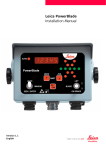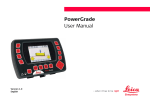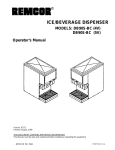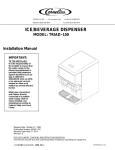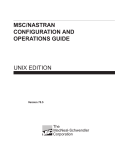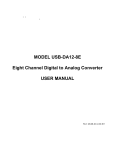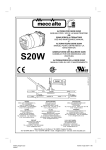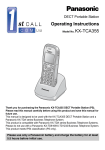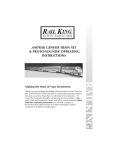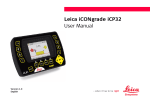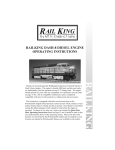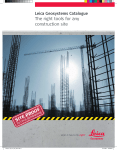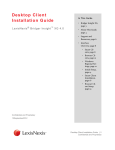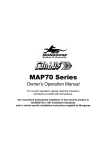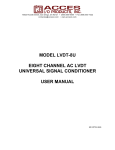Download Power Blade_UM.book
Transcript
Leica PowerBlade User Manual Version 1.1 English PowerBlade, Introduction 2 Introduction Purchase Congratulations on your purchase of the Leica PowerBlade machine control system. PowerBlade is an ideal tool for increasing productivity and land-levelling quality of construction earthmoving and agricultural land-levelling applications. This manual contains important safety directions as well as instructions for setting up the system and operating it. Refer to "6 Safety Directions" for further information. Read carefully through the User Manual before you switch on the product. To ensure safety when using the system, please also observe the directions and instructions contained in the User Manual and Safety Handbook issued by the: • Machine manufacturer. Product identification PowerBlade, Introduction The type and serial number of your products are indicated on the label on the base of the unit. Enter the model and serial number in your manual and always refer to this information when you need to contact your agency or Leica Geosystems authorised service workshop. Type: MCP700/700E Serial No.: _________________________ Type: MLS700/700E Serial No.: _________________________ Type: MPM700 Serial No.: _________________________ 3 PowerBlade, Introduction Symbols 4 The symbols used in this manual have the following meanings: Type Danger Warning Caution Description Indicates an imminently hazardous situation which, if not avoided, will result in death or serious injury. Indicates a potentially hazardous situation or an unintended use which, if not avoided, could result in death or serious injury. Indicates a potentially hazardous situation or an unintended use which, if not avoided, may result in minor or moderate injury and/or appreciable material, financial and environmental damage. Important paragraphs which must be adhered to in practice as they enable the product to be used in a technically correct and efficient manner. To use the equipment in the permitted manner, please refer to the detailed safety instructions in the User Manual. © 2010 Leica Geosystems AG, Heerbrugg, ® All rights reserved. About This Manual PowerBlade Leica PowerBlade is a machine control system that provides the machine operator with visual guidance and/or automatic control of the working tool, for example dozer blade or scraper box, relative to a reference elevation (grade) provided by a rotating laser. The PowerBlade panel is designed to be easy to use, and provides the operator with a range of information and set-ups to assist machine control operation. Major components The PowerBlade system consists of several components, depending on the type of machine and the customer’s needs to perform earthmoving tasks. The basic components of the systems are a control panel, laser receiver, manual mast or power mast, and distinct hydraulic valve for the automatic control of the working tool for dozer, agriculture machines such as scrapers, or any kind of land-levellers. Some machines like farm drainage machines have already the hydraulic valves installed. Applicability of this manual This manual covers the following components: For North and South America, Europe, Africa, Middle East, South-East Asia, Australia, New Zealand: • MCP700 PowerBlade panel • MLS700 Laser Receiver • MPM700 PowerMast For India only: • MCP700E PowerBlade panel (regional variant of MCP700) • MLS700E Laser Receiver (regional variant of MLS700) PowerBlade, About This Manual 5 PowerBlade, Table of Contents 6 Table of Contents In this manual Topic 1 Page Product Overview 1.1 1.2 1.3 1.4 2 General MCP700/700E PowerBlade Control Panel MLS700/700E Laser Receiver MPM700 Power Mast 8 8 10 15 16 Basic Operation 18 2.1 2.2 2.3 2.4 2.5 18 21 23 27 28 Manual Operation Automatic Operation Survey Operation Setup Modes User Menu 3 Check List 30 4 Cable Schematics 34 4.1 4.2 34 37 Cables Wiring Diagrams 5 6 7 PowerBlade, Table of Contents Care and Transport 40 5.1 5.2 5.3 5.4 40 41 42 43 General Notices Transport Storage Cleaning and Drying Safety Directions 44 6.1 6.2 6.3 6.4 6.5 6.6 6.7 6.8 44 45 46 47 48 49 54 56 General Intended Use Limits of Use Responsibilities International Warranty, Software Licence Agreement Hazards of Use Electromagnetic Compatibility EMC FCC Statement, Applicable in U.S. Technical Data 60 7.1 60 General Technical Data 7 PowerBlade, Product Overview 1 Product Overview 1.1 General General Leica Geosystems' PowerBlade system offers operators complete flexibility and control of the grade cut by many kinds of heavy machinery such as dozers, scrapers, boxblades, tractor-towed scrapers and trenching machines. PowerBlade is designed for accurate control and on-grade performance with superior reliability in the harshest construction or agricultural land-levelling applications. PowerBlade is a single channel control system for grade control (only elevation, no slope) of the working tool. Warning Warning 8 This product may be installed on construction or agricultural machinery only by an appropriately trained and qualified specialist. Unauthorised modification of machines by mounting the product may alter the function and safety of the machine. Precautions: Follow the instructions of the machine manufacturer. If no appropriate instruction is available, ask machine manufacturer for instructions before mounting the product. Function of Automatic Control System A rotating laser, for example Leica Rugby series, rotates to provide a reference plane of laser light over an entire jobsite. This plane of laser light can be level, single-slope, or dual-slope. A 360° Laser Sensor, mounted to a mast directly over the cutting edge of the blade, receives (senses) the plane of laser light. The Grade Position LEDs on the laser sensor flash to indicate the location of the blade's cutting edge relative to the required finished grade. (The control panel in the cab has a set of LEDs that mimic the laser sensor's LEDs.) • • In manual control, the operator watches the Grade Position Lamps and uses the machine's controls to keep the center LED lit, thereby keeping the blade on-grade. In automatic control, the automatic control system controls the working tool’s hydraulic cylinder to keep the center LED lit, thereby keeping the blade on-grade. Components of PowerBlade system a b c d e f a) b) c) d) e) f) PowerBlade, Product Overview Rotating laser Plane of laser light Laser mast Laser receiver PowerBlade panel Hydraulic valve 9 PowerBlade, Product Overview 1.2 MCP700/700E PowerBlade Control Panel General The MCP700/700E Control Panel is the heart of the system. It processes the signal sent to the panel from the laser receiver (and optionally the Power Mast) and regulates or controls the working tool elevation via the attached hydraulic valve. 10 The MCP700/700E Control Panel allows the operator to work in any of three modes: manual, automatic, or survey mode with the optional power mast. In the manual mode, the operator of the machine controls the hydraulics of the machine manually, watching either the flashing LED's of the sensor or the LEDs of the control panel, to keep the sensor centered on the beam and the machine on-grade. For automatic operation, the system electrically regulates the hydraulics of the machine to raise/lower the working tool, keeping it "on grade". In normal operation the sensor and mast are fixed at a specific distance above the cutting edge of the working tool. In the survey mode with the optional power mast, the sensor and mast are moving. As the machine moves across the contours of the field, the changes in the mast's height are recorded in the panel. These recordings can then be averaged at the end of each row or after the finished survey to determine an optimal (averaged) target elevation for the working area, for example jobsite or field, for levelling. The MCP700/700E Control Panel can operate in inches, feet, or centimeters with either 12 V DC or 24 V DC machine power. The MCP700/700E Control Panel provides power to the other system components. See specifications for further information. Control panel overview a b c a) b) c) d) e) f) g) h) i) d Power On/Off -Switch PowerBlade, Product Overview e f g h i j k j) k) Auto Indication LED Display LED Height Indication Switch Auto-Manual-Seek/Enter Connector Sensor/Mast Zero Button (ZERO and Raise Button) Connector Power Power ON-Off Button Average Button (DOWN and Lower Button) Connector Hydraulic Switch Mast Control + Hydraulic Allows operators to control power to the system. • ON - Power is applied to the system • OFF - Power is removed from the system. • Turns the panel ON or OFF; used with the mode toggle switch to enter the Survey Mode and other special setup functions 11 PowerBlade, Product Overview 12 Mast Raise / Lower Push Button These buttons have multiple functions depending on the operating mode of the panel. In the Main Operating mode: • Raise arrow moves the mast up • Lower arrow moves the mast down. In the Survey mode: • Raise arrow (ZERO) is pressed to clear the current average and set the number of readings to 0. • Lower arrow (AVERAGE) is pressed to get the current average mast height and number of readings In the Setup mode, the buttons have a special function to set the count in the display to a user-determined value in the units selected by the operator: • Raise arrow increases the count value in the display • Lower arrow decreases the count value in the display. LED Display The sensor height indication provides a numeric LED display for grade indication in automatic and manual modes. AUTO Indicator AUTO Indicator LED: Identifies the operating mode • ON - Automatic Mode, Hydraulics controlled to laser beam • OFF - Manual Mode, Hydraulics controlled manually • Flashing - The panel is in automatic mode, but there is no laser beam detected. LED Height Indication LEDs • top very slow flash • top fast • top and center fast • center fast • bottom and center fast • bottom fast • bottom very slow flash AUTO, MANUAL, SEEK/ENTER Toggle Switch The function of this switch depend on whether the panel is in Operating or Survey mode. The panel normally starts up in Operating mode; See later in this document for instructions on how to enter survey mode. Meaning Lost Laser Far above grade Above grade On grade Below grade Far below grade Lost laser Operating mode In • • • Operating mode, the switch functions are: AUTO - Automatic Mode - hydraulics controlled to laser beam MANUAL - Manual Mode - hydraulics controlled manually SEEK - Drives optional power mast to find laser beam. Not applicable to manual mast systems. Survey mode In Survey mode, the switch functions are: • AUTO - Automatic Survey Mode - Drives mast to stay on laser beam and takes mast height samples at 3 second intervals automatically. • MANUAL - Manual Survey Mode - Drives mast to stay on laser beam; mast height samples only taken when the switch is moved to the "Enter" position. • ENTER - Takes a single sample of the mast height each time the switch is moved to this position. PowerBlade, Product Overview 13 PowerBlade, Product Overview Hydraulics Raise/Lower Switch 14 The functions of this switch depend on the operating mode of the panel and whether the optional power mast is installed. • In Manual Mode, moving the switch to the up arrow position raises the blade; moving the switch to the down position lowers the blade. • In Automatic Mode with the optional power mast, moving this switch to the LIFT position lowers the mast a pre-set amount so the blade is raised to keep the sensor on the laser beam. The blade will be raised one step each time the switch is moved to the LIFT position. Moving the switch down to the ON GRADE position causes the mast to be raised to the original height causing the blade to drive down to keep the sensor on the laser beam. When the Lift value is set to 0, or on a manual mast system, this switch acts like in Manual Mode. Connectors a b c The control panel has three connectors a) Laser Sensor: Provides a connection for the cable leading to the Laser Sensor or Power Mast. b) Power Input: Provides a connection to the machine's battery. (PowerBlade can operate on 12 or 24 Volt machines.) c) Hydraulic Output: Provides a connection for the communications cable with the Valve Assembly. 1.3 MLS700/700E Laser Receiver General The MLS700/700E Laser Receiver is the eye of the system. The sensor receives the rotating beam of laser light and indicates its position as it strikes the sensor. This information is then transferred electronically to the control panel. The sensor provides five distinct positions of the laser beam. Used for automatic or manual control, the flashing LED lights are ideally suited for all machine control applications. Laser Receiver overview a b c d e Height Indication PowerBlade, Product Overview a) b) c) d) e) Off Grade High On Grade Of Grade Low 4 photocell columns for 360° reception of the laser plane Connector LEDs • top very slow flash • top fast • top and center fast • center fast • bottom and center fast • bottom fast • bottom very slow flash Meaning Lost Laser Far above grade Above grade On grade Below grade Far below grade Lost laser 15 PowerBlade, Product Overview 1.4 16 MPM700 Power Mast Power Mast overview The MPM700 Power Mast adjusts the laser receiver elevation to lock onto the laser reference beam. Once set, the mast provides a direct relationship to the cutting depth of the working tool. The mast can be raised or lowered from the cab of the machine by means of a switch on the control panel. The amount of change is shown in the LED display on the panel. L E I C A G E O S Y S T E M S When used for surveying, the mast moves up and down as the machine moves across the field, keeping the sensor centered on the laser beam, recording the height changes (or contours) of the field into the panel's memory. These readings can then be averaged at the end of each row or after the finished survey. Leica Geosystems recommends the use of a shock mount for all Power Mast applications to prevent the mast system from being damaged by severe mechanical shock. PowerBlade, Product Overview 17 PowerBlade, Basic Operation 2 Basic Operation 2.1 Manual Operation Manual Operation with Manual Mast When the system is being used for manual operation, the Mode switch should be in the MANUAL position. When in MANUAL, there is no output signal sent to the hydraulics of the machine and the operator of the machine manually controls the hydraulics to keep the sensor centered on the laser beam. In the manual mode, the following operations can be performed: The graphic LEDs will provide the high, low, or on grade indications. Hydraulics Raise/Lower Switch This switch is used to raise or lower the hydraulics of the machine, but only if the machine has been equipped for automatic control. 18 Manual Operation with Power Mast When the system is being used for manual operation, the Mode switch should be in the MANUAL position. When in MANUAL, there is no output signal being sent to the hydraulics of the machine and the operator of the machine manually controls the hydraulics to keep the sensor centered on the laser beam. In the manual mode, the following operations can be performed: Mast Raise/Lower Pushbutton These can be used to raise or lower the mast to a new position or to center the sensor on the laser beam. Grade Display The graphic LEDs will provide the high, low, or on grade indications. Manual Operation with BLADE/LIFT/ON GRADE SWITCH In Manual operation with a Power Mast the switch can be used to preform a lift, if the lift value is bigger then 0, but the driver still needs to raise the blade him self. If the lift value is 0 then the switch is used to raise or lower the blade. With the Mode switch in the MANUAL position, the hydraulics will raise or lower when the hydraulic switch is activated and will remain in this new position when the switch is released. PowerBlade, Basic Operation 19 PowerBlade, Basic Operation Mode Switch This switch should be in the middle neutral or MANUAL position for manual operation; it may be placed in the SEEK position (momentary action) to initiate the SEEK function. SEEK Function This is used to drive the optional power mast to find the laser beam automatically. After placing the Mode switch in the SEEK position and releasing it, all LEDs in the graphic grade display will flash. Press either the Mast Raise/Lower Pushbutton to cause the mast to start moving in the up or down direction to find the beam. If the mast reaches a limit without finding the beam, it will automatically reverse and travel in the other direction to find the beam. If the mast reaches a second limit without finding the beam, the system will terminate the SEEK operation. 20 2.2 Automatic Operation Automatic Operation When the system is being used for automatic operation, the system must be in the normal operating mode with the Mode switch in the AUTO position. The machine must be equipped for hydraulic laser control. The panel will send signals to the hydraulic solenoid valves based on the laser sensor inputs to automatically raise and lower the cylinder and keep the sensor centered on the laser beam. In the automatic mode, the following operations can be performed: Mast Raise/Lower Pushbutton These can be used to raise or lower the mast to a new position or to center the sensor on the laser beam. Changing the mast height with these buttons also changes the height of the grade. Raise/Lower Switch In Automatic Operation this switch can only be used to raise or lower the blade, if the LIFT value is set to 0. Refer to "2.1 Manual Operation" and "Manual Operation with BLADE/LIFT/ON GRADE SWITCH" on page 19 for further explanations. PowerBlade, Basic Operation 21 PowerBlade, Basic Operation External Automatic Switch 22 Mounted on the blade control lever or at a different location easily reached by the operator, the master switch enables the operator to use a single move to enable or disable automatic control on all channels with automatic control selected on the control panel. Mode switch This switch should be in the UP or AUTO position for automatic operation. The SEEK position of this switch is used to do a SEEK with the Power Mast. Lift/On Grade Switch The functions of the Blade Hydraulics Raise/Lower Switch: In the AUTO mode, momentary operation of this switch will allow the operator to lower the mast and, therefore, LIFT the blade of the machine one user-defined step each time the switch is activated. When the switch is placed in the ON GRADE position, the blade and mast will return to their original positions. This gives the operator a method of consistently raising his blade and then returning again to their original grade. • If the panel is switched to MANUAL, the ON GRADE function will be disabled until returned to AUTO. 2.3 Survey Operation General With the optional power mast, the system has the ability to record and average the changes in the contours of the land. The survey function can be used for row, full field, and perimeter surveys. The average and number of readings can be displayed in the counter at any time. Entering Survey Mode When surveying, the machine's blade is raised and the hydraulics do not react to information from the laser system. Instead, the mast will move up and down as the machine moves across the contours of the land and will keep the sensor centered on the laser beam. It is the movements of the mast that are being recorded and then averaged. Preparation for/before Survey • Turn on the panel. • Put the blade at a height where it won't touch the ground during the survey. • Make a Seek to find the laser beam, and adjust the mast height to the value you want the survey to start from. Keep in mind that the power mast should be around the middle of its total travel range to allow plenty of elevation change (of the field) in both directions. • Turn off the panel. Activate Survey Mode • Activate Survey Mode by entering the Survey option in the USER MENU press and hold the MODE switch to Seek and simultaneously press the On/Off button. • Navigate to survey option with Mast up/down keys, to select survey function release the MODE switch and toggle between ON or OFF with Mast up/down keys. When the panel is powered down it will disable the survey mode PowerBlade, Basic Operation 23 PowerBlade, Basic Operation 24 Survey Procedure • The user can start surveying when he has gone through the Activate Survey procedure. It can either be done by putting the Auto/Enter switch in to Auto, or toggle it down to Enter. • By putting it into Auto the panel reads the mast height every 3. Sec and adds it to the sum value in the memory, and increment the number of recorded points by 1. • Pressing the switch to Enter and release it, adds the current mast height to the sum value, and also increment the number of recorded points by 1. • When the switch is in the manual position the panel still displays the Average/Count, but no new points are recorded. It is also possible to clear the Average/Count when the switch is in manual. Detailed Description of Enter Auto Mast Up (keep pressed) Mast Down Blade Up Blade Down buttons and switches Manually add one sample to the survey average. Automatic Sampling (1 sample per 3 sec.) Clear Average Value and number of points taken. Toggle the display of Average/Count (average is shown as standard when survey mode is activated.) No action No action (Blade Up and Down doesn't have any function when the panel is in survey mode) If at some point during the survey the power mast reaches its top/bottom limit, the display will show POLE to indicate that the average is now false since the mast cannot move further up or down. To start over press the Zero button, the current Average will be cleared and you must start surveying again. If at any point during Survey Mode operation, the panel is switched off, it will automatically exit Survey Mode. Survey mode In Survey mode, the following operations can be performed: Average Button When the average button is pressed, the LED counter will display alternately the average of the readings taken and the number of readings taken. Zero Button The average and the readings stored in the panel’s memory can be cleared by pressing and holding the clear button until the display blinks. Mode Switch This switch should be in the UP or AUTO position for surveying operations with automatic sampling, and the manual position for manual sampling: With the Mode switch in the AUTO position, readings will automatically be taken at 3 second intervals and stored into memory. With the Mode switch in the MANUAL position, the control panel will take a reading manually each time the Mode switch is moved to the ENTER position. The Survey mode is exited by turning the panel off and then on again. PowerBlade, Basic Operation 25 PowerBlade, Basic Operation Description of the Survey Function 26 Counter must be set to zero before starting surveying function. Mast should be positioned somewhere in the middle of the range to allow movement up and down. Startup Survey Mode • Turn on the panel. • Put the blade at a height were it won’t touch the ground during the survey. • Make a Seek to find the laser beam, and adjust the mast height to the value you want the survey to start from. Keep in mind that the mast should be around the middle position to have the biggest travel range in both directions. • Turn off the panel. Activate Survey Mode • Activate Survey Mode by entering the Survey Option in the USER MENU press and hold the MODE switch to Seek and simultaneously press the On/Off button. • Release the ON/OFF button and navigate to Survey Option with Mast up/down keys, to select survey function release the MODE switch and toggle between ON of OFF with Mast up/down keys. • Grade Indication LEDs are constantly blinking, function of buttons and toggle switches change. Enter Auto Mast Up (ZERO)(keep pressed) Mast Down (AVG) Blade Up Blade Down Manually add one sample Automatic Sampling (1 sample per 3 sec.) Clear Toggle the display of Average/Count No action No action Exit Survey Mode • Push On/Off button and LEDs stop flashing 2.4 Setup Modes Entering the Setup Modes The MCP700/700E provides two setup modes: • USER setup - for all general options selectable by the user. TECHNICIAN setup - will be covered in the installation manual. USER setup The USER setup mode is used for configuring system parameters and to go into the survey operating mode. Enter User setup The USER setup mode is entered as follows: • Press ON / OFF button to turn off the panel. • Move MODE switch to SEEK position and hold it, while simultaneously pressing the ON / OFF button to turn on the system. • Continue to hold MODE switch in SEEK position, and use Mast up/down keys to select desired user menu option. Refer to "2.5 User Menu" for more information. • Release MODE switch, then use Mast up/down keys to set required value. • To select another user menu option, move MODE switch again to SEEK position, use Mast up/down keys to switch to desired option. • To save all changes and exit USER setup mode, go to the blank menu (LED display goes blank) and release MODE switch. PowerBlade, Basic Operation 27 PowerBlade, Basic Operation 28 2.5 User Menu General If the Survey Mode is selected, the system will start operation in the Survey Mode and stay in Survey Mode until power is switched off. When the system is turned back on, it will come up in normal operating mode. User Menu Options LIGHT - Sets the display brightness - standard value is 15. LASER SENSOR DEADBAND - Select laser sensor deadband value in user-selected units. - standard value is 3. Settings represent values in mm 1 = 2 mm 2 = 7 mm 3 = 11 mm 4 = 15 mm 5 = 25 mm UNITS - Selects the desired units for the mast height display: • CEnt - Metric - CCCC.C centimeters • FEEt - Feet - FFF.FF feet • InCH - Inches - IIII.I inches Lift Steps - sets the value of the mast height steps used in the LIFT function with optional Power Mast. LIFT Step value is in the user selected units. A lift step value of 0.0 disables the lift function. Survey Mode - puts the panel in survey operation mode. Count direction -Two options are available . Positive - corresponds to mast grade level of the blade, count increases with increased mast height. Negative - corresponds to mast grade level of the blade, count decreases with increased mast height. PowerBlade, Basic Operation 29 PowerBlade, Check List 30 3 Check List General If the PowerBlade system is not functioning properly, the first step is to determine the problem component. Use the information in this section to isolate the problem. Caution Caution Most Obvious Causes (Check First) The following test equipment is needed: • Voltage/Ohm Meter • Rotating laser or laser simulator • Cable Wiring Diagram (See cable schematics in this section.) To prevent serious damage to the PowerBlade system, never replace fuses with fuses that have a higher amperage rating than prescribed. PowerBlade is a highly sophisticated electronic system. Do not attempt repairs to the components. Contact Leica Geosystems or your local authorised Leica Geosystems dealer if you have any problems. • • • • • Is the power switch on the PowerBlade Panel switched on and does the LED light come up? Is the fuse in the battery cable good? Is the connection to the battery good? Is the PowerBlade system getting sufficient power from the battery? Are the cables all connected correctly and in good condition? Control Panel 1. Check if the power is switched on an the display lights up. 2. Check the battery for proper continuity and connection. 3. Check the power source (battery). 4. Check the fuse at the battery cable. 5. Check the fuses on the circuit board. 6. A main fuse is accessible from outside the panel. Fuse size 10 Amps (Dim. 5x20mm) 7. Power to circuit board electronics and Laser Sensor? Power Mast? 8. Check if the PowerBlade Panel has been set-up correctly for the operation required Laser Sensor 1. Check and clean the glass covering the sensor's photo cells. Condensation for example caused by placing a cold receiver into a warm working environment, and jobsite dust can cause serious interference to the laser signal. 2. Check fuse on the control panel or if used with external battery cable check the fuse on the cable. 3. Check the cable to the sensor for proper continuity. 4. Check all cable connections for dirt, corrosion, bent or broken pins, etc. 5. Do the Grade Position LEDs become lit and go through the proper sequence when the Power ON push button is press? 6. Do the Grade Position LEDs function properly when laser light from a rotating laser or a laser simulator activates the photo cells? 7. Does the laser receiver show erratic lights? Check for condensation, dust or secondary reflection of the laser beam from nearby glass, mirrored, reflective or highly-polished surfaces. Cables 1. Check all cables periodically for wear, dirt, corrosion, bent or broken pins, or other damage. 2. Check cable continuity. (See cable schematics in section 4.) PowerBlade, Check List 31 PowerBlade, Check List 32 Hydraulics 1. Check all hydraulic hoses and connections periodically for damage and wear. 2. Check all adjustments and locking nuts for tightness. 3. Check cables and electrical connections to the solenoids. 4. Check for cylinder leaks. 5. Check the settings for the hydraulic if it is set to the valve installed. 6. Check the values of the hydraulic tuning if they are the same values as done during the installation. Rotating Laser 1. Check to be sure the rotating laser is functioning properly by testing it with a hand-held sensor (if available). 2. Check to be sure that the Laser Sensor is within the specified operating range (elevation window) of the rotating laser. 3. Check to be sure that the rotating laser's light is not reflecting off other surfaces, causing multiple readings by the Laser Sensor. 4. Check if wind, rain, dust, engine exhaust, etc. is interfering with the laser receiver's reception. 5. Check if the head rotating speed is set properly. (Refer to the rotating laser user manual.) 6. Check that the rotating laser does not have dead zones enabled if available. PowerBlade, Check List 33 PowerBlade, Cable Schematics 34 4 Cable Schematics 4.1 Cables The following standard system cables cannot be used with MCP700E and MLS700E: MYC700, MSC701, MSC702, MSC705, MSC706, MCC700, MCC701, MVC700 and MVC702. Overview cable Description Product name Schematic Cable Panel to MYC700 battery fused, 8m a) Brown positive b) Blue negative c) -Auto/Man F1) Fuse 10 Amps a b c Cable Panel to 760871, battery, fused Power cable, 3-pin, fused a F1 c C A B b a) Brown positive b) Blue negative c) -Auto/Man F1) Fuse 10 Amps Description Product name Schematic Straight Cable MSC702 mast to panel, 8m Coiled sensor cable, 3 m or 12 m options A D A D B C B C A PowerBlade, Cable Schematics A+ BCAN CAN No. 1 No. 2 No. 3 No. 4 A B C D A+ BCAN CAN No. 1 No. 2 No. 3 No. 4 MCC700 (3 m) MCC701 (12 m) B Remote Auto/Manual switch A B C D D A D C B C MSC705 35 PowerBlade, Cable Schematics Description 36 Product name Schematic Hydraulic Valve MVC700 cable, 9 m 1 A D B C 4 3 2 A) 1 N/C B) 2 Common C) 3 Lower D) 4 Raise 4.2 Wiring Diagrams PowerBlade with Manual Mast configuration (MCP700/MLS700 systems only) a b e PowerBlade, Cable Schematics d c a) MCC700 Coiled Cable 3 m (ext.) MCC701 Coiled Cable 12 m (ext.) b) MVC700 Straight Cable, Hydraulic, 9m c) MSC700 Y- Power Cable , 8 m w/fuse d) MSC705 Auto/Manual switch e) MSC703 Straight Cable extension, 3m MSC704 Straight Cable extension, 8m MVC702 Hydraulic Cable, Danfoss, 9m MVC701 Hydraulic Extension Cable, 3m 37 PowerBlade, Cable Schematics 38 PowerBlade with Power Mast configuration (MCP700/MLS700/ MPM700 systems only) e a b c f d MCC700 Coiled Cable 3 m (ext.) MSC702 Straight Cable, 8 m MSC705 Auto/Manual switch MSC700 Y- Power Cable , 8 m w/fuse e) MVC700 Cable Power, 8 m w/fuse f) MSC703 Straight Cable extension, 3m MSC704 Straight Cable extension, 8m MVC702 Hydraulic Cable, Danfoss, 3m MVC701 Hydraulic Extension Cable, 3m a) b) c) d) PowerBlade, Cable Schematics 39 PowerBlade, Care and Transport 5 Care and Transport 5.1 General Notices General information Servicing the system only requires a minimum of time. All electronic components are enclosed in robust housings to safeguard them against mechanical damage. Periodic checks If any PowerBlade components are or subjected to severe impact, be sure to check for proper operation prior to performing any work with the system. 40 5.2 Transport Transport in the field When transporting the equipment in the field, always make sure that you carry the product in its original transport container. Transport in a road vehicle Never carry the product loose in a road vehicle, as it can be affected by shock and vibration. Always carry the product in its transport container and secure it. Shipping When transporting the product by rail, air or sea, always use the complete original Leica Geosystems packaging, transport container and cardboard box, or its equivalent, to protect against shock and vibration. Field adjustment After transport inspect the field adjustment parameters given in this user manual before using the product. PowerBlade, Care and Transport 41 PowerBlade, Care and Transport 42 5.3 Storage Product Respect the temperature limits when storing the equipment, particularly in summer if the equipment is inside a vehicle. Refer to "7 Technical Data" for information about temperature limits. Field adjustment After long periods of storage inspect the field adjustment parameters given in this user manual before using the product. 5.4 Cleaning and Drying Product • • Cables and Plugs Keep plugs clean and dry. Blow away any dirt lodged in the plugs of the connecting cables. Damp products Dry the products at a temperature not greater than 40°C/108°F and clean them. Do not repack until everything is completely dry. Blow off dust. Use a clean, soft, lint-free cloth for cleaning. If necessary, moisten the cloth with water or pure alcohol. Do not use other liquids; these may attack the polymer components. PowerBlade, Care and Transport 43 PowerBlade, Safety Directions 6 Safety Directions 6.1 General Description The following directions should enable the person responsible for the product, and the person who actually uses the equipment, to anticipate and avoid operational hazards. The person responsible for the product must ensure that all users understand these directions and adhere to them. 44 6.2 Intended Use Permitted use • • • Adverse use • • • • • • • • • • • Warning Automatic control of machine blade in height, based on reference height, reference line, and machine geometry. Detection of a desired reference height. Adjustment of machine hydraulic system performance and machine geometry Use of the product without instruction. Use outside of the intended limits. Disabling safety systems. Removal of hazard notices. Opening the product using tools, for example screwdriver, unless this is specifically permitted for certain functions. Modification or conversion of the product. Use after misappropriation. Use of products with obviously recognizable damages or defects. Use with accessories from other manufacturers without the prior explicit approval of Leica Geosystems. Inadequate safeguards at the work site, for example working on roads. Controlling of machines, moving objects or similar monitoring application without additional control- and safety installations. Adverse use can lead to injury, malfunction and damage. It is the task of the person responsible for the equipment to inform the user about hazards and how to counteract them. The product is not to be operated until the user has been instructed on how to work with it. PowerBlade, Safety Directions 45 PowerBlade, Safety Directions 46 6.3 Limits of Use Environment Suitable for use in an atmosphere appropriate for permanent human habitation: not suitable for use in aggressive or explosive environments. Danger Local safety authorities and safety experts must be contacted before working in hazardous areas, or in close proximity to electrical installations or similar situations by the person in charge of the product. 6.4 Responsibilities Manufacturer of the product Leica Geosystems AG, CH-9435 Heerbrugg, hereinafter referred to as Leica Geosystems, is responsible for supplying the product, including the user manual and original accessories, in a completely safe condition. Manufacturers of non Leica Geosystems accessories The manufacturers of non Leica Geosystems accessories for the product are responsible for developing, implementing and communicating safety concepts for their products, and are also responsible for the effectiveness of those safety concepts in combination with the Leica Geosystems product. Person in charge of the product The person in charge of the product has the following duties: • To understand the safety instructions on the product and the instructions in the user manual. • To be familiar with local regulations relating to safety and accident prevention. • To inform Leica Geosystems immediately if the product and the application becomes unsafe. Warning Warning Warning The person responsible for the product must ensure that it is used in accordance with the instructions. This person is also accountable for the training and the deployment of personnel who use the product and for the safety of the equipment in use. Unauthorised modification of machines by mounting the product may alter the function and safety of the machine. Precautions: Follow the instructions of the machine manufacturer. If no appropriate instruction is available, ask machine manufacturer for instructions before mounting the product. This product may be installed on building machinery only by an appropriately trained and qualified specialist. PowerBlade, Safety Directions 47 PowerBlade, Safety Directions 48 6.5 International Warranty, Software Licence Agreement International Warranty The International Warranty can be downloaded from the Leica Geosystems home page at http://www.leica-geosystems.com/internationalwarranty or received from your Leica Geosystems dealer. Software Licence Agreement This product contains software that is preinstalled on the product, or that is supplied to you on a data carrier medium, or that can be downloaded by you online pursuant to prior authorization from Leica Geosystems. Such software is protected by copyright and other laws and its use is defined and regulated by the Leica Geosystems Software Licence Agreement, which covers aspects such as, but not limited to, Scope of the Licence, Warranty, Intellectual Property Rights, Limitation of Liability, Exclusion of other Assurances, Governing Law and Place of Jurisdiction. Please make sure, that at any time you fully comply with the terms and conditions of the Leica Geosystems Software Licence Agreement. Such agreement is provided together with all products and can also be found at the Leica Geosystems home page at http://www.leica-geosystems.com/swlicense or your Leica Geosystems dealer. You must not install or use the software unless you have read and accepted the terms and conditions of the Leica Geosystems Software Licence Agreement. Installation or use of the software or any part thereof, is deemed to be an acceptance of all the terms and conditions of such licence agreement. If you do not agree to all or some of the terms of such licence agreement, you may not download, install or use the software and you must return the unused software together with its accompanying documentation and the purchase receipt to the dealer from whom you purchased the product within ten (10) days of purchase to obtain a full refund of the purchase price. 6.6 Warning Caution Warning Warning Hazards of Use Only Leica Geosystems authorised service workshops are entitled to repair these products. Installing near mechanically moving machine components may damage the product. Precautions: Deflect the mechanically moving machine components as far as possible and define a safe installation zone. Accuracy of the cross-slope is directly related to the position of the rotation sensor on grader applications, and is degraded whenever the rotation sensor is not in line with the longitudinal (lengthwise) axis of the machine. The amount of degradation depends on the specific machine designs and will be different on various brands and models. Precautions: Exercise caution in steep slope applications to ensure the desired grade accuracy. Beware of inadequate steering if machine is defective like after a crash or other damaging events or alterations to the machine. Precautions: Periodically perform control measurements and field adjustments on the machine as specified in the User Manual. While working, construction and grading should be checked by appropriate means, for example spirit level, tachymeter, before and after important measuring tasks. PowerBlade, Safety Directions 49 PowerBlade, Safety Directions Warning Warning Caution 50 While steering or navigating the machine accidents may occur due to a) the operator not paying attention to the surroundings (persons, ditches, traffic, etc.), or b) malfunctions (…of a system component, interference, etc). Precautions: The operator assures that the machine is operated, guided and monitored by a qualified user (e.g. driver). The user has to be able to take emergency measures, for example an emergency stop. The absence of instruction, or the inadequate imparting of instruction, can lead to incorrect or adverse use, and can give rise to accidents with far-reaching human, material, financial and environmental consequences. Precautions: All users must follow the safety directions given by the manufacturer and the directions of the person responsible for the product. Watch out for erroneous measurement results if the product has been dropped or has been misused, modified, stored for long periods or transported. Precautions: Periodically carry out test measurements and perform the field adjustments indicated in the user manual, particularly after the product has been subjected to abnormal use and before and after important operations. Danger Warning Caution Caution Because of the risk of electrocution, it is very dangerous to use poles and extensions in the vicinity of electrical installations such as power cables or electrical railways. Precautions: Keep at a safe distance from electrical installations. If it is essential to work in this environment, first contact the safety authorities responsible for the electrical installations and follow their instructions. By surveying during a thunderstorm you are at risk from lightning. Precautions: Do not carry out field surveys during thunderstorms. During hydraulics testing parts of the machine are moved automatically, regardless of the position of the master switch. This could lead to bodily injury. Precautions: Make sure that no persons are standing within the operating range of the machine during hydraulic testing. System Components can protrude from the machine, which could lead to bodily injury and/or product damage. Precautions: Exercise caution in operation to avoid striking any objects or persons near the working area. PowerBlade, Safety Directions 51 PowerBlade, Safety Directions Warning Warning Warning Caution 52 During dynamic applications, there is a danger of accidents occurring if the user does not pay attention to the environmental conditions around, for example obstacles, excavations or traffic. Precautions: The person responsible for the product must make all users fully aware of the existing dangers. Inadequate securing of the work site can lead to dangerous situations, for example in traffic, on building sites, and at industrial installations. Precautions: Always ensure that the work site is adequately secured. Adhere to the regulations governing safety and accident prevention and road traffic. If computers intended for use indoors are used in the field there is a danger of electric shock. Precautions: Adhere to the instructions given by the computer manufacturer with regard to field use in conjunction with Leica Geosystems products. If the accessories used with the product are not properly secured and the product is subjected to mechanical shock, for example blows or falling, the product may be damaged or people may sustain injury. Precautions: When setting-up the product, make sure that the accessories, for example tripod, tribrach, connecting cables, are correctly adapted, fitted, secured, and locked in position. Avoid subjecting the product to mechanical stress. Warning If the product is improperly disposed of, the following can happen: • If polymer parts are burnt, poisonous gas are produced which may impair health. • If batteries are damaged or are heated strongly, they can explode and cause poisoning, burning, corrosion or environmental contamination. • By disposing of the product irresponsibly you may enable unauthorised persons to use it in contravention of the regulations, exposing themselves and third parties to the risk of severe injury and rendering the environment liable to contamination. • Improper disposal of silicone oil may cause environmental contamination. Precautions: Dispose of the product appropriately in accordance with the regulations in force in your country. Always prevent access to the product by unauthorised personnel. PowerBlade, Safety Directions 53 PowerBlade, Safety Directions 54 6.7 Electromagnetic Compatibility EMC Description The term Electromagnetic Compatability is taken to mean the capability of the product to function smoothly in an environment where electromagnetic radiation and electrostatic discharges are present, and without causing electromagnetic distur-bances to other equipment. Warning Caution Caution Electromagnetic radiation can cause disturbances in other equipment. Although the product meets the strict regulations and standards which are in force in this respect, Leica Geosystems cannot completely exclude the possibility that other equipment may be disturbed. There is a risk that disturbances may be caused in other equipment if the product is used in conjunction with accessories from other manufacturers, for example field computers, personal computers, two-way radios, non-standard cables or external batteries. Precautions: Use only the equipment and accessories recommended by Leica Geosystems. When combined with the product, they meet the strict requirements stipulated by the guidelines and standards. When using computers and two-way radios, pay attention to the information about electromagnetic compatibility provided by the manufacturer. Disturbances caused by electromagnetic radiation can result in erroneous measurements. Although the product meets the strict regulations and standards which are in force in this respect, Leica Geosystems cannot completely exclude the possibility that the product may be disturbed by very intense electromagnetic radiation, for example, near radio transmitters, two-way radios or diesel generators. Precautions: Check the plausibility of results obtained under these conditions. Warning If the product is operated with connecting cables attached at only one of their two ends, for example external supply cables, interface cables, the permitted level of electromagnetic radiation may be exceeded and the correct functioning of other products may be impaired. Precautions: While the product is in use, connecting cables, for example product to external battery, product to computer, must be connected at both ends. PowerBlade, Safety Directions 55 PowerBlade, Safety Directions 6.8 Warning Warning 56 FCC Statement, Applicable in U.S. This equipment has been tested and found to comply with the limits for a Class B digital device, pursuant to part 15 of the FCC rules. These limits are designed to provide reasonable protection against harmful interference in a residential installation. This equipment generates, uses and can radiate frequency energy and, if not installed and used in accordance with the instructions, may cause harmful interference to radio communication. However, there is no guarantee that interference will not occur in a particular installation. If this equipment does cause harmful interference to radio or television reception, which can be determined by turning the equipment off and on, the user is encouraged to try to correct the interference by one or more of the following measures: • Reorient or relocate the receiving antenna. • Increase the separation between the equipment and the receiver. • Connect the equipment into an outlet on a circuit different from that to which there ceiver is connected. • Consult the dealer or an experienced radio/TV technician for help. Changes or modifications not expressly approved by Leica Geosystems for compliance could void the user's authority to operate the equipment. Labelling MCP700 PowerBlade Control Panel T ype: MCP700 Pow er: 10-30V ---, 0,2A max Leica G eosystems AG CH-9435 Heerbrugg M anufactured 2007 Made in Denmark A rt.N o. 7xxxxx S .N o. 123456 T h is d ev i c e co m p li es w i th p a r t 15 of t h e F C C R u l es . O p e r a ti o n i s s u bjec t to th e fo ll o w i ng tw o co nd i tio n s : (1) T hi s d ev i c e m a y n o t c a u s e h a rm ful i n terfer en c e, a nd (2) th i s d ev ic e m u s t a c c ept a n y in ter fer en c es r ec eiv ed, i n cl ud in g i n t er fer en c e th a t m a y c a u s e un des i r ed o pe r a ti o n . Labelling MCP700E PowerBlade Control Panel T ype: MCP700E Pow er: 10-30V ---, 0,2A max Leica G eosystems AG CH-9435 Heerbrugg M anufactured 2007 Made in Denmark A rt.N o. 7xxxxx S .N o. 123456 T h is d ev i c e co m p li es w i th p a r t 15 of t h e F C C R u l es . O p e r a ti o n i s s u bjec t to th e fo ll o w i ng tw o co nd i tio n s : (1) T hi s d ev i c e m a y n o t c a u s e h a rm ful i n terfer en c e, a nd (2) th i s d ev ic e m u s t a c c ept a n y in ter fer en c es r ec eiv ed, i n cl ud in g i n t er fer en c e th a t m a y c a u s e un des i r ed o pe r a ti o n . PowerBlade, Safety Directions 57 PowerBlade, Safety Directions 58 Labelling MLS700 Laser Receiver T ype: MLS700 Pow er: 10-30V ---, 0,2A max Leica G eosystems AG CH-9435 Heerbrugg M anufactured 2007 Made in Denmark A rt.N o. 7xxxxx S .N o. 123456 T h is dev ice co m p li es w i th pa rt 15 of th e F C C R u les . O p era tio n is s u bjec t to th e fo ll o w i ng tw o co nd i tio n s : (1) T hi s d ev i c e m a y n o t c a u s e h a rm ful i n terfer en c e, a nd (2) th i s d ev ic e m u s t a c c ept a n y in ter fer en c es r ec eiv ed, i n cl ud in g i n t er fer en c e th a t m a y c a u s e un des i r e d o pe r a ti o n . Labelling MLS700E Laser Receiver T ype: MLS700E Pow er: 10-30V ---, 0,2A max Leica G eosystems AG CH-9435 Heerbrugg M anufactured 2007 Made in Denmark A rt.N o. 7xxxxx S .N o. 123456 T h is dev ice co m p li es w i th pa rt 15 of th e F C C R u les . O p era tio n is s u bjec t to th e fo ll o w i ng tw o co nd i tio n s : (1) T hi s d ev i c e m a y n o t c a u s e h a rm ful i n terfer en c e, a nd (2) th i s d ev ic e m u s t a c c ept a n y in ter fer en c es r ec eiv ed, i n cl ud in g i n t er fer en c e th a t m a y c a u s e un des i r e d o pe r a ti o n . Labelling MPM700 Power Mast L E I C A T ype: MPM700 Pow er: 10-30V ---, 0,2A max Leica G eosystems AG CH-9435 Heerbrugg M anufactured 2007 Made in Denmark A rt.N o. G E O S Y S T E M S 7xxxxx S .N o. 123456 T h is dev i ce co m p li es w i th pa rt 15 of th e F C C R u les . O p era tio n is s u bjec t t o t h e fo ll o w i ng t w o co nd i t io n s : ( 1) T hi s d ev i c e m a y n o t c a u s e h a rm ful i n terfer en c e, a nd (2) th i s d ev ic e m u s t a c c ept a n y in ter fer en c es r ec eiv ed, i n cl ud in g i n t er fer en c e th a t m a y c a u s e un des i r ed o pe r a ti o n . PowerBlade, Safety Directions 59 PowerBlade, Technical Data 60 7 Technical Data 7.1 General Technical Data The MCP700/700E is designed to operate from standard vehicle power systems at 12 V DC or 24 V DC - check to ensure proper connection and polarity. Environmental System Accuracy MCP700/700E Parameter Specification Humidity max. 95% RH, non condensing System Accuracy ± 2mm * (Standard Deviation) * Depending on sensors in use, operating range (distance between laser transmitter and receiver), stated accuracy of laser transmitter, calibration of laser transmitter, atmospheric condition (wind speed, temperature, humidity, pressure, presence of dust, etc.), machine condition, machined material. Temperature Waterprotection Unit Operating temperature [°C] Storage temperature [°C] MCP700/700E Control Panel -20 to +60 -30 to +70 MLS700/700E Receiver -20 to +60 -30 to +70 MPM700 Power Mast -20 to +60 -30 to +70 MCP700/700E: MLS700/700E: MPM700: IP 65 IP 68 IP 45 MCP700/700E Control Panel PowerBlade, Technical Data Parameter Specification Voltage range 12/24 Volts dc (nom.) Current consumption < 800 mA without Power Mast < 2.5 A with Power Mast Interfaces 1x CAN-Interface Hydraulic Output Settings Proportional Valves Dimensions 6.7 x 3 x 4.7 inches ( 17 x 7.5 x 12 cm) Weight 3.3 lbs (1.5 kg) 61 PowerBlade, Technical Data MCP700/700E Laser Receiver 62 Parameter Specification Voltage range 12/24 Volts dc (nom.) Current consumption < 500 mA Accuracy Dead Bands 1 2 3 4 5 Stand alone 7 mm Narrow Band 25 mm Wide Band Sensor Pick-Up Range 7.5 in. (19 cm) Laser Requirement All rotating lasers (HeNe or Infrared Laser diodes visible and invisible) Pulsed Display 5 pulses per second Operating Range 1000 ft. (300 m) Radius Weight 5.5 lbs. (2.5 kg) = = = = = 2 mm 7 mm 11 mm 15 mm 25 mm The Laser Receiver can be used for manual (visual) control by connecting directly to the battery. MPM700 Power Mast PowerBlade, Technical Data Parameter Specification Voltage range 12/24 Volts dc (nom.) Current consumption < 2.5 A Mast travel 48 inches (1.2 m ) Mast Height (transport length) 72.6 inches (1.84 m) Mast Travel Speed 3.35 inches (85 mm) per second (12 V machines); 3.93 inches (100 mm) per second (24 V machines) Weight 66 lbs. (30 kg) 63 Ask your local Leica Geosystems dealer for more information about our TQM program. Leica Geosystems AG Heinrich-Wild-Strasse CH-9435 Heerbrugg Switzerland Phone +41 71 727 31 31 www.leica-geosystems.com Original text 760816-1.1.0en Leica Geosystems AG, Heerbrugg, Switzerland, has been certified as being equipped with a quality system which meets the International Standards of Quality Management and Quality Systems (ISO standard 9001) and Environmental Management Systems (ISO standard 14001). Printed in Switzerland © 2010 Leica Geosystems AG, Heerbrugg, Switzerland Total Quality Management: Our commitment to total customer satisfaction.
































































